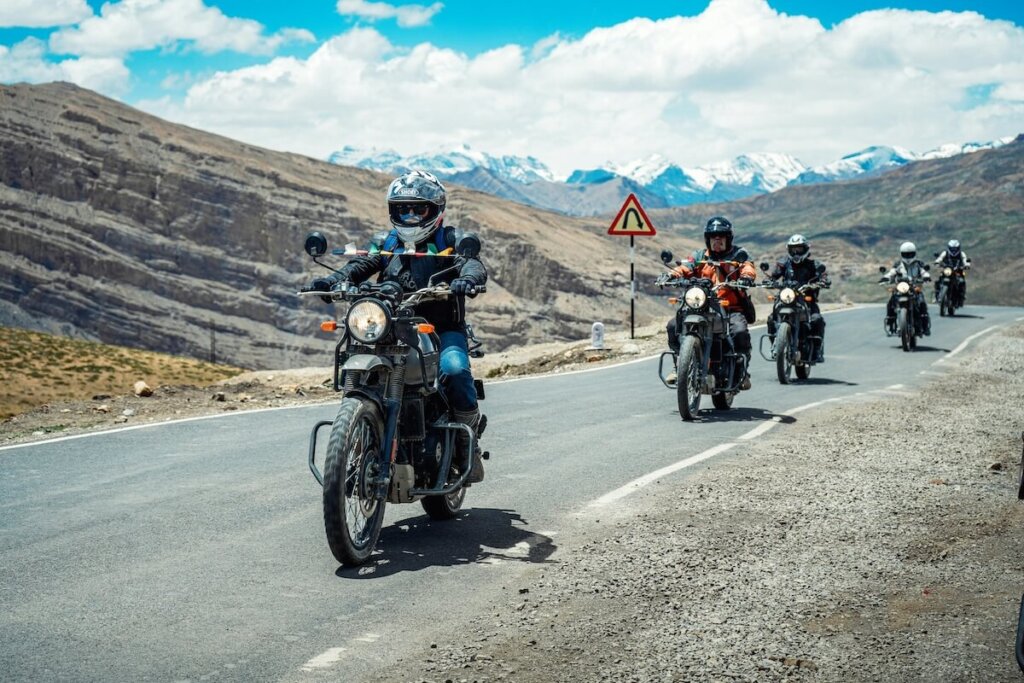Spiti Valley, often called “Little Tibet”, is a high-altitude desert mountain valley in Himachal Pradesh, known for its rugged landscapes, ancient monasteries, and untouched beauty.
While popular spots like Key Monastery, Chandratal, and Kibber attract most travelers, the real magic of Spiti Valley lies in its offbeat places—remote, serene, and far from the tourist crowds.
If you’re looking for hidden Spiti, secret trails, or unexplored villages, this guide will take you through the most offbeat places in Spiti Valley, including lesser-known spots around offbeat Kaza, where adventure meets solitude.
Manali To Kaza Spiti Circuit Isn’t Offbeat
Most travelers stick to the usual Spiti Valley circuit—Manali to Kaza via Kunzum Pass, covering Key Monastery, Langza, and Kibber. But beyond these well-trodden paths lie hidden valleys, forgotten hamlets, and remote monasteries that offer a raw, unfiltered experience.
Exploring offbeat Spiti means:
- Avoiding crowds and experiencing solitude.
- Discovering untouched landscapes where nature remains pristine.
- Meeting locals in remote villages, far from commercialization.
- Finding unique photography spots that most tourists miss.
If you’re an adventurer seeking something different, these secret Spiti destinations should be on your list.
Offbeat Places In Spiti Valley
1. Demul – The Last Authentic Spitian Village
A Remote Hamlet Frozen in Time
Located at 4,350 meters, Demul is one of the highest inhabited villages in Spiti and remains untouched by mass tourism. Unlike the more famous Komic or Hikkim, Demul retains its raw charm, with traditional mud houses, barley fields, and warm locals who still follow centuries-old customs.
Why Visit Demul?
- Homestay Experience: Unlike Kaza or Kibber, Demul offers authentic homestays where you can live like a local, eating Spitian food and hearing folklore.
- Starry Nights: With zero light pollution, Demul is one of the best places for astrophotography in Spiti.
- Hiking Trails: Trek to Lalung or Komic for breathtaking views of the valley.
How to Reach?
Demul is 35 km from Kaza, but the road is rough and only suitable for SUVs or bikes. It’s best visited between June-September.
2. Gue – The Mummy Village of Spiti
A Mysterious Village with a 500-Year-Old Secret
Gue is famous for the naturally preserved mummy of a Buddhist monk, believed to be over 500 years old. Unlike Egypt’s mummies, this one was preserved without chemicals—just Spiti’s dry, cold climate.
Why Visit Gue?
- The Mummy Monastery: A small temple houses the mummy, which still has hair and teeth intact.
- Off-the-Grid Location: Very few tourists visit Gue, making it a hidden Spiti treasure.
- Scenic Drive: The route from Sumdo to Gue is one of the most beautiful yet least explored roads in Spiti.
How to Reach?
Gue is 65 km from Kaza, near the India-Tibet border. You’ll need an Inner Line Permit (ILP) to visit.
3. Dhankar Lake – A Hidden Trekker’s Paradise
The Secret Lake Above Dhankar Monastery
Most tourists visit Dhankar Monastery, but few hike up to Dhankar Lake, a pristine blue lake perched at 4,270 meters. The 1.5-hour trek from the monastery is moderately challenging but rewards you with surreal views.
Why Visit Dhankar Lake?
- Solitude: Unlike Chandratal, you’ll likely have the lake to yourself.
- Panoramic Views: Overlooks the entire Spiti Valley and Pin Valley.
- Spiritual Vibes: The lake is considered sacred by locals.
Best Time to Visit
The trek is accessible from June to October. Avoid monsoons (July-August) due to slippery trails.
4. Lhalung – The Hidden Monastery Village
One of Spiti’s Oldest and Least-Visited Monasteries
Lhalung, meaning “Land of the Gods”, is home to Lhalung Monastery, older than Key Monastery but far less crowded. The village is surrounded by golden barley fields and offers a peaceful retreat.
Why Visit Lhalung?
- Ancient Murals: The monastery has stunning 15th-century Buddhist paintings.
- Authentic Culture: Unlike touristy Kaza, Lhalung feels untouched.
- Great for Slow Travel: Stay in a homestay and absorb the village life.
How to Reach?
Lhalung is 45 km from Kaza, en route to Demul. The road is rough but worth it.
5. Tashigang – The Forbidden Village of Spiti
A Restricted Village with a Sacred Cave
Tashigang is one of the least-visited villages in Spiti, requiring a special permit due to its proximity to the border. It’s home to a sacred cave where Guru Padmasambhava meditated.
Why Visit Tashigang?
- Mystical Vibes: The cave is said to have spiritual energy.
- Zero Tourists: Only a handful of travelers make it here.
- Unique Landscape: Rocky cliffs and deep valleys surround the village.
Permit Requirements
You need an ILP from Kaza SDM office. Best visited between June-September.
6. Kibber Wildlife Sanctuary – Beyond the Famous Village
A Hidden Wildlife Haven
Most people visit Kibber village, but few explore the Kibber Wildlife Sanctuary, home to snow leopards, ibex, and blue sheep.
Why Explore the Sanctuary?
- Wildlife Spotting: Winter (Dec-Feb) is best for snow leopard sightings.
- Offbeat Trekking: Trails lead to remote corners of Spiti.
- Silence & Solitude: Far from the usual tourist trail.
Best Time to Visit
- Summer (June-Sept): For trekking.
- Winter (Dec-Feb): For snow leopards (with a guide).
7. Losar – The Last Village Before Kunzum Pass
A Quiet Village with Stunning Views
Losar is the last inhabited village before Kunzum Pass (connecting Spiti to Lahaul). Most travelers stop briefly, but staying overnight reveals its charm.
Why Stay in Losar?
- Sunset Views: Stunning hues over the Spiti River.
- Base for Treks: Start point for Pin Bhaba Pass trek.
- Less Commercial: No fancy cafes, just raw beauty.
How to Reach?
Losar is 60 km from Kaza, on the Manali-Kaza route.
Also Read: this article for camping throughout Spiti Valley Circuit.
Why Offbeat Spiti is Worth It
While Kaza, Key Monastery, and Chandratal are undeniably spectacular, they represent just the surface of what Spiti Valley has to offer. The real magic of this high-altitude desert lies in its untouched corners, where time stands still, and nature and culture remain unspoiled by mass tourism.
Unlike the more commercialized stops, remote villages like Demul, Lhalung, and Gue offer a rare glimpse into traditional Spitian life. Here, you won’t find souvenir shops or crowded cafés—instead, you’ll share meals with locals in their centuries-old mud houses, listen to folktales by the fire, and witness Buddhist rituals that have remained unchanged for generations.
- Homestays Over Hotels: In places like Demul and Komic, you’ll sleep in family-run homestays, eating tsampa (roasted barley flour), thukpa, and butter tea—meals prepared with love, not for profit.
- Festivals & Local Traditions: If you time your visit right, you might witness Ladarcha Fair (Kaza) or local monastery festivals where masked dances and ancient rituals come alive.
Spiti’s offbeat trails are where you’ll truly feel the vastness of the Himalayas. Unlike the crowded viewpoints at Chandratal or Key Monastery, places like:
- Dhankar Lake – A silent, high-altitude trek where you might be the only soul for miles.
- Gue’s Mummy Temple – A mysterious, rarely visited site with an eerie yet fascinating history.
- Tashigang’s Sacred Cave – A spiritual retreat where monks still meditate in isolation.
These spots offer meditative silence, where the only sounds are the wind, distant prayer flags, and the occasional marmot whistle.
For photographers and adventurers, offbeat Spiti is a goldmine:
- Astrophotography: Demul and Losar have zero light pollution, making them perfect for Milky Way shots.
- Wildlife Encounters: The Kibber Wildlife Sanctuary is one of the few places where you might spot a snow leopard or Tibetan wolf in winter.
- Hidden Trekking Routes: Trails like Pin Bhaba Pass (from Mudh to Kaza) or the Lalung Valley walk are untouched alternatives to mainstream hikes.
If you crave real off-roading, Spiti’s hidden routes deliver:
- River Crossings & Rocky Trails: The road to Gue and Tashigang is not for the faint-hearted—narrow, unpaved, and thrilling.
- High-Altitude Challenges: Villages like Demul (4,350m) and Komic (4,587m) test your acclimatization, offering a raw, unfiltered Himalayan experience.
Essential Tips for Offbeat Spiti Travel
To make the most of your journey into Spiti’s hidden corners, keep these pro tips in mind:
1. Travel in a 4×4 – Many Roads Are Rough & Unpredictable
- Why? Most offbeat routes (like Gue, Demul, Tashigang) have no proper roads—just rocky, river-crossing paths. A Mahindra Thar, Scorpio, or Suzuki Jimny is ideal.
- Bonus Tip: If renting, opt for a local Spiti driver—they know the terrain better than GPS!
2. Carry Cash – ATMs Are Rare & Unreliable
- Where to Withdraw? Kaza has the last reliable ATMs (SBI & HDFC). Beyond that, carry at least ₹5,000–10,000 in cash for homestays, fuel, and permits.
- Small Notes Matter: Remote villages may not have change for ₹500/₹2,000 notes.
3. Respect Local Culture – Seek Permission Before Photographing
- Monasteries & People: Always ask before clicking monks, locals, or religious ceremonies. Some monasteries charge a small fee for photography.
- Dress Modestly: Spiti is deeply Buddhist—avoid shorts/sleeveless in villages.
4. Pack Warm – Nights Are Freezing, Even in Summer
- Layers Are Key: Daytime (15°C) vs. nighttime (-5°C) temps vary wildly. Pack:
- Thermal inners
- Down jacket
- Woolen socks & gloves
- Balaclava (for wind protection)
- Sleeping Bags: Many homestays provide blankets, but a -10°C rated bag ensures comfort.
5. Mobile Network? Only BSNL Works (Sometimes)
- No Jio/Airtel: Beyond Kaza, only BSNL postpaid gets sporadic signals.
- Offline Maps: Download Google Maps (offline) or Maps.me for navigation.
6. Permits for Border Villages (Gue, Tashigang, Nako)
- Inner Line Permit (ILP): Required for villages near the Tibet border. Get it from the Kaza SDM office (carry ID proof + 2 passport photos).
- Check Road Status: Some areas (like Kunzum Pass) close unexpectedly due to snow/landslides

